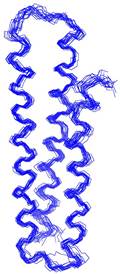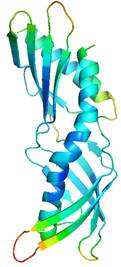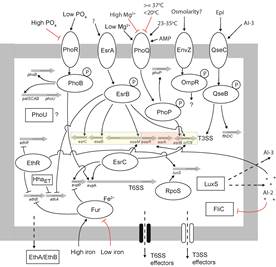
MOK YU-KEUNG HENRY
Associate Professor and Deputy Head of Department
Contact Information:
Department of Biological Sciences
National University of Singapore
14 Science Drive 4
Singapore 117543
6516 2967
6779 2486
dbsmokh@nus.edu.sg
Research Areas
Protein NMR and folding
Research Interests
Our general interest is on the elucidation of protein structure-function relationship using Nuclear Magnetic Resonance (NMR) or X-ray crystallography, particularly on proteins related to human diseases. An understanding of the role played by a protein in human disease requires a detailed picture of its three-dimensional structure and how it interacts with its target ligand as well as an appreciation of how the structure varies as a function of time due to molecular dynamics. Protein structural and dynamical data obtained will aid the design of protein mutants and subsequent activity or binding assays, as well as rational design of drug or therapeutic methods.
Current Projects
Two main themes related to human diseases are currently being studied in our laboratory: (a) Proteins involved in dust mite allergy, asthma and atopic dermatitis. We have determined the structure and mapped IgE epitopes of dust mite and cockroach allergens including Blo t 13, Blo t 5, Blo t 21, Bla g 4, Per a 4 and Der f 7. Currently, we are investigating on structural characterization of wild type and SNP mutants of proteins involved atopic dermatitis, including dermcidin antibacterial peptides and filaggrin S100 proteins; (b) Structural characterization of the complexes of chaperone and apparatus/translocator of bacterial type III and VI secretion systems. In addition, regulation of the expression of the type III and VI secretion systems by two-component systems, such as PhoP/PhoQ and PhoQ/PhoR, in response to host and environmental factors are also being studied.

NMR ensemble of dust mite allergen Blo t 21

Crystal structure of dust mite allergen Der f 7
 Regulation of the type III and VI secretion systems by two-component systems
Regulation of the type III and VI secretion systems by two-component systems
Selected Publications
-
Varsha Ashok Walvekar, Karthik Ramesh, Muthu Kannan, R. Manjunatha Kini, J. Sivaraman and Yu Keung Mok (2022), “Scaffold stability and P14’ residue steric hindrance in the differential inhibition of FXIIa by Aedes aegypti trypsin inhibitor versus Infestin-4”, Bioscience Reports, 42, BSR20220421.
-
Varsha Ashok Walvekar, Karthik Ramesh, Chacko Jobichen, Muthu Kannan, J. Sivaraman, R. Manjunatha Kini, and Yu Keung Mok (2021), “Crystal structure of Aedes aegypti trypsin inhibitor in complex with μ-plasmin reveals role for scaffold stability in Kazal-type serine protease inhibitor”, Protein Science, doi: 10.1002/pro.4245
-
Ahmed Sayed, Smarajit Chakraborty, Ka Yin Leung, Shigeki Sugii and Yu Keung Mok (2020), “Trxlp, a thioredoxin-like effector from Edwardsiella piscicidainhibits cellular redox signaling and nuclear translocation of NF-κB”, International Journal of Biological Macromolecule, 148, 89-101.
-
Karthik Ramesh, Varsha A. Walvekar, Benjamin Wong, Ahmed Mahmoud Syed, Dorothée, R. Manjunatha Kini, Yu Keung Mok and Julien Pompon (2019), “Increased mosquito midgut infection by dengue virus recruitment of plasmin is blocked by an endogenous Kazal-type inhibitor”, iScience, 21, 564-576. | LINK
-
Karthik Ramesh, Dilraj Lama, Kang Wei Tan, Van Sang Nguyen, Fook Tim Chew, Chandra S. Verma and Yu Keung Mok (2018), “Homologous LEKTI domains delay blood coagulation by inhibiting factor X and XI with differential specificity”,Structure, 26, 1-9. doi: 10.1016/j.str.2018.05.018
-
Van Sang Nguyen, Kang Wei Tan, Karthik Ramesh, Fook Tim Chew and Yu Keung Mok (2017), “Structural basis for the bacterial membrane insertion of dermcidin peptide, DCD-1L”, Scientific Reports, 7,
-
Van Sang Nguyen, Chacko Jobichen, Kang Wei Tan, Yih Wan Tan, Siew Leong Chan, Karthik Ramesh, Yongming Yuan, Yunhan Hong, Ka Yin Leung, J. Sivaraman and Yu-Keung Mok (2015), “Structure of AcrH-AopB chaperone-major translocator complex reveals the role of membrane hairpins in T3SS translocon assembly”, Structure, 23, 2022-2031.
-
Wentao Hu, Ganesh Anand, J. Sivaraman, Ka Yin Leung and Yu-Keung Mok (2014), “A disordered region in the EvpP protein from the type VI secretion system of Edwardsiella tardais essential for EvpC binding”, PLoS ONE, 9, e110810.
-
Kang Wei Tan, Tan Ching Ong, Yun Feng Gao, Yuen Sung Tiong, Kang Ning Wong, Fook Tim Chew and Yu Keung Mok (2012), “NMR structure and IgE epitopes of Blo t 21, a major dust mite allergen from Blomia tropicalis”, Biol. Chem., 287, 34776-34785.
-
Kang Wei Tan, Chacko Jobichen, Tan Ching Ong, Yun Feng Gao, Yuen Sung Tiong, Kang Ning Wong, Fook Tim Chew, J. Sivaraman and Yu Keung Mok (2012), “Crystal structure and IgE epitopes of Der f 7, a dust mite allergen from Dermatophagoides farinae”, PLoS ONE, 7(9), e44850.
-
Smarajit Chakraborty, J. Sivaraman, Ka Yin Leung and Yu-Keung Mok (2011), “PhoB-PhoR and Ferric Uptake Regulator senses phosphate and iron to regulate virulence genes in type III and VI secretion systems of Edwardsiella tarda”, Biol. Chem., 286, 39417-39430.
-
Chiradip Chatterjee, Sundramurthy Kumar, Smarajit Chakraborty, Yih Wan Tan, Ka Yin Leung, J. Sivaraman and Yu-Keung Mok (2011), “Crystal structure of the heteromolecular chaperone, AscE-AscG, from the type III secretion system in Aeromonas hydrophila”, PLoS ONE, 6, e19208.
-
Smarajit Chakraborty, Mo Li, Chiradip Chatterjee, J. Sivaraman, Ka Yin Leung and Yu-Keung Mok (2010), ‘Temperature and Mg2+ sensing by a novel PhoP-PhoQ two-component system for regulation of virulence in Edwardsiella tarda‘, Biol. Chem., 285, 38876-38888.
-
Ka Yin Leung, Bupe A. Siame, Heather Snowball and Yu-Keung Mok (2010), ‘Type VI secretion regulation: crosstalk and intracellular communication’, Opin. Microbiol., 14, 1-7.
-
Janarthanan Krishnamoorthy, Victor C.K. Yu, Yu-Keung Mok, ‘Auto-FACE: An NMR based binding site mapping program for fast chemical exchange protein-ligand systems’, PLoS ONE, published 18 Feb 2010, doi:10.1371/journal.pone.0008943 >> article
-
Yih Wan Tan, Hong Bing Yu, J. Sivaraman, Ka Yin Leung and Yu-Keung Mok (2009), ‘Mapping of the chaperone AcrH binding regions of translocators AopB and AopD and characterization of oligomeric and metastable AcrH-AopB-AopD complexes in the type III secretion system of Aeromonas hydrophila‘,Protein Sci., 18, 1724-1734.
-
Yih Wan Tan, Siew Leong Chan, Tan Ching Ong, Le Yau Yit, Yuen Sung Tiong, Fook Tim Chew, J. Sivaraman and Yu-Keung Mok (2009) ‘Structures of two major allergens, Bla g 4 and Per a 4, from cockroaches and their IgE binding epitopes’, Biol. Chem., 284, 3148-3157.
-
Yih Wan Tan, Hong Bing Yu, Ka Yin Leung, J. Sivaraman and Yu-Keung Mok (2008) Structure of AscE and induced burial regions in AscE and AscG upon formation of the chaperone needle-subunit complex of type III secretion system in Aeromonas hydrophila, Protein Sci., vol. 17, p. 1748-1760
-
Siew Leong Chan, Tan Ching Ong, Yun Feng Gao, Yuen Sung Tiong, De Yun Wang, Fook Tim Chew, and Yu Keung Mok (2008) ‘Nuclear Magnetic Resonance structure and IgE epitopes of Blo t 5, a major dust mite allergen’, Immunology, 181, p. 2586-2596.
-
Yong-Hong Zhang, Anirban Bhunia, Kah Fei Wan, Mei Chin Lee, Shing-Leng Chan, Victor C.-K. Yu and Yu-Keung Mok (2006) Chelerythrine and sanguinarine docks at distinct sites on BclXL that are not the classic “BH3 binding cleft”, Mol. Biol., vol. 364, p. 536-549.
-
Siew Leong Chan, Seow Theng Ong, Su Yin Ong, Fook Tim Chew, and Yu Keung Mok (2006) “NMR structure based epitope mapping and modulation of dust mite Group 13 allergen as a hypoallergen”, Journal of Immunology, 176, p. 4852-4860.
-
Xing-Fu Xu, Yih-Wan Tan, Lam Lam, Jim Hackett, Mingjie Zhang and Yu-Keung Mok (2004) “NMR Structure of a Type IVb Pilin from Salmonella typhi and its Assembly into Pilus”, Biol. Chem., vol. 279, p. 31599-31605
-
Mok, Y-K, Lo, K. W-H & Zhang, M.J., ‘Structure of Tctex-1 and its interaction with cytoplasmic dynein intermediate chain’, Biol. Chem.,(2001) 276 (17):14067-14074.
-
Mok, Y-K, Elisseeva, E.L., Davidson, A.R. & Forman-Kay, J.D. ‘Dramatic stabilization of an SH3 domain by a single substitution: role of the unfolded state’, Mol. Biol.,(2001) 307 (3):913-928.
-
Mok, Y-K, Alonso, L.G., Lima, M.T.R., Bycroft, M. & Prat-Gay, G. d. ‘Folding of a dimeric b-barrel: residual structure in the urea denatured state of the Human Papillomavirus E2 DNA binding domain’, Protein Science, (2000) 9:1-13.
-
Mok, Y-K, Kay, L.E. & Forman-Kay, J.D. ‘NOE data and structure calculation on a 15 N/deuterated drk SH3 domain demonstrating a compact unfolded state under native conditions’, Mol. Biol., (1999) 289 (3):619-638.
-
Mok, Y-K, Bycroft, M. & Prat-Gay, G. d. ‘The dimeric DNA binding domain of the human papillomavirus E2 protein folds through a monomeric intermediate which cannot be native-like’, Nature Struct. Biol., (1996) 3:711-717.
